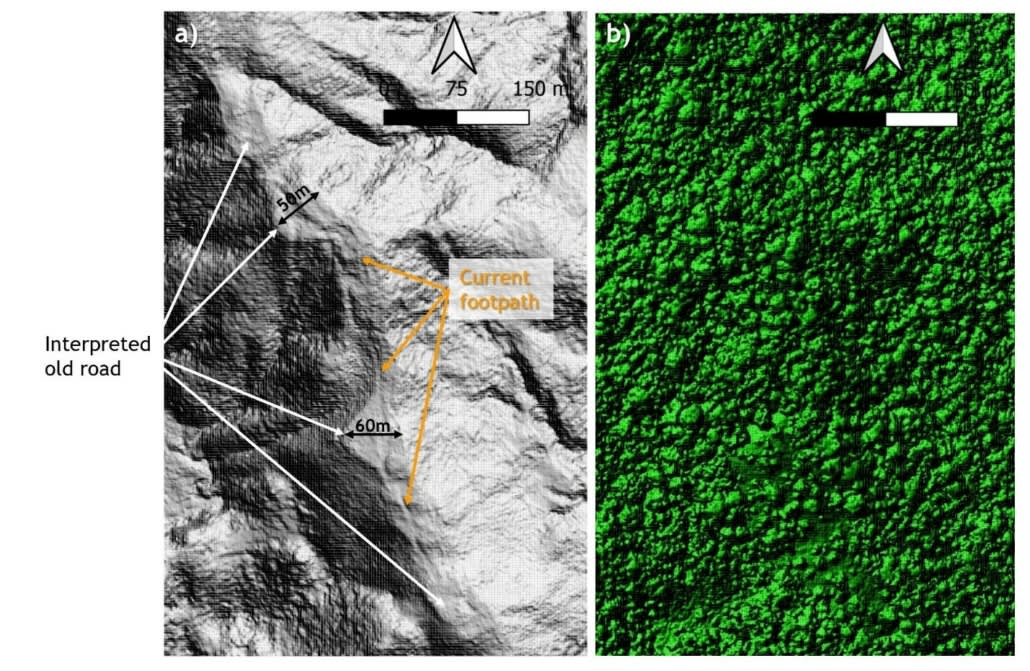Toronto, Ontario, May 8, 2020 – Aurania Resources Ltd. (TSXV: ARU) (OTCQB: AUIAF) (Frankfurt: 20Q) (“Aurania” or the “Company”) is pleased to report that a possible road has been identified beneath deep jungle cover in LiDAR imagery in the central part of the Lost Cities – Cutucu Project (“Project”) in southeastern Ecuador. The feature that is interpreted as a very old road needs to be verified and assessed in the field by a qualified and Ecuador-registered archeologist as soon as the COVID-related restrictions are lifted in the Project area.
Aurania’s Chairman & CEO, Dr. Keith Barron commented, “LiDAR has provided us with a powerful tool to augment our exploration toolkit. We’re using the LiDAR in two principal areas: to refine our geological targets for gold and copper exploration; and secondly, to identify possible remnants of infrastructure from Colonial Spanish times related to gold mining in the “lost cities” of Logroño and Sevilla. Along with the 2.5km road segment discovered by our field teams late last year, currently being evaluated by a registered archeologist and the National Institute of Cultural Heritage of Ecuador, we believe that the feature identified in the LiDAR data represents infrastructure related to that mining activity. However, this LiDAR interpretation requires further verification in the field. We are making good use of our time during the COVID-related shutdown to take a very close look at our LiDAR data and integrate it with our large geophysics and geochemistry databases.”
Details of the Possible Road Segment
A “bare earth” image, in which the jungle cover response has been digitally removed, shows a flat area along a ridge crest in the central part of the Project area. A footpath, which is currently used by the local people, is superimposed on the broader, road-like feature that is up to 60 metres (“m”) wide, and is interpreted to be an engineered structure built by the Colonial Spanish. LiDAR imagery of the top of the jungle canopy and SPOT satellite photography shows that the flat corridor is indistinguishable from the surrounding jungle – it appears that it is completely tree-covered, which is consistent with this being an old feature. Field work by a registered archeologist is required to confirm that the feature is man-made, and this will be prioritized when COVID-related restrictions are lifted in Ecuador. Subsequent to the archeologist’s investigation, the feature may require further study by the National Institute of Cultural Heritage of Ecuador.
The Company has prepared a draft “Back to Work” protocol for review by the Ministry of Energy and Non-Renewable Natural Resources, to be implemented when COVID-related restrictions are lifted in the Morona Santiago Province in which the Project lies. The detailed timing of a normalized work situation is not yet clear.

Figure 1. a) LiDAR “Bare Earth” image showing the road-like feature, which is up to 60m wide, and the superimposed footpath that is currently in use by the local people; b) the same area showing the LiDAR image of the jungle canopy in which the road-like structure is imperceptible.
About LiDAR
LiDAR stands for Light Detection And Ranging, and is a method by which millions of pulses of light are directed downwards from an aircraft, in our case, a helicopter, flying about 500m above the ground. The pulses are reflected back to a detector, and instantaneous measurements of the distance travelled result in an image of the surface. In dense jungle, the vast majority of the reflections are off the vegetation, but some pulses do get through to the floor of the jungle. The classification of the data determines the furthest reflection and assumes that it was reflected off the ground, to provide a “bare earth” image in which it appears that the vegetation has been removed. Our LiDAR survey of priority areas of the Lost Cities – Cutucu Project has provided the first-ever view of the earth’s surface beneath the jungle cover, producing a snapshot of geological features, including layers in sedimentary rocks. The images show fault systems spectacularly well – and these are important because they provide the plumbing system that brings metal-bearing fluids from deep in the earth’s crust to environments in which ore deposits are likely to form. Most known gold deposits throughout the world are located adjacent to geological faults – hence our focus on these structures in our exploration.
Details of the LiDAR Survey
The survey was undertaken by MPX Geophysics Ltd of Ontario, Canada, with a helicopter and crew contracted from Avioandes, of Quito, Ecuador. The survey was flown at a mean terrain clearance of 500m, with an average line spacing of 250m, using 100% LiDAR swath overlap.